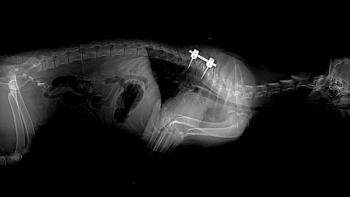
New review helps illuminate cognitive dysfunction syndrome
Without cold, hard lab numbers and clear scientific proof, diagnosing neurologic conditions in your veterinary patients can be tough to describe, and without owner buy-in, they can be tough to treat. However, a recent review provides a starting point for providing clients with objective evidence.
Getty ImagesDo you ever see ads for drugs treating various veterinary diseases and syndromes and think, “I've never even heard of X disease-Are they making this whole thing up just to sell medications?!”
This thought has crept into my mind many times. It's not that I'm trying to be overly skeptical (or cynical), but some diseases and syndromes are easier to demonstrate than others. When I diagnose kidney failure, for example, I can point to lab results to substantiate my case. Numbers help me feel empowered to have a straightforward discussion with the client about the patient's condition. Who can argue with cold, hard facts?
Diagnosing cognitive dysfunction syndrome (CDS), on the other hand, is different, because living patients cannot be definitively diagnosed. It's a tough conversation to have with clients when my arsenal of proof is devoid of black and white numbers, or even just some clear scientific evidence that supports the diagnosis. But CDS is real, and a recent article in Veterinary Pathology can help illuminate the condition for both you and your clients.
Ch-ch-changes in the brain
While aging is associated with many changes, those that occur in the brain are especially important because of the behavioral and cognitive effects they can cause. And as veterinarians, we need to understand these changes in order to help our clients improve the lives of their aging pets.
Age-related cognitive decline that cannot be attributed to other medical conditions, such as sensory deficit, infection or cancer, is termed CDS in veterinary medicine. It is analogous to Alzheimer's disease in people.
Some consider CDS to be a reasonable model for studying Alzheimer's disease because the patterns of impairment (such as memory loss) are comparable, as are the histopathologic changes, like amyloid plaques and cerebral amyloid angiopathy.
Each of these dogs is not like the other
There is a tremendous amount of variability in how dogs progress as they age. Some show cognitive decline while others continue to function like younger animals. For example, a study of cognitive dysfunction in older beagles produced three different categories: successful agers, impaired dogs and severely impaired dogs.1
CDS has only recently been recognized in cats. One study estimates that over one-fourth of cats between the ages of 11 and 14 experience cognitive decline, and the proportion swells to over one half for cats 15 and older.2 Although cognitive dysfunction has not been documented in horses, many think they experience it, as well.
Clients with older pets may mention observing disorientation, sleep cycle disruption, inappropriate urination and activity changes in their cats and dogs. It is critical to rule out non-age-related causes of these changes before CDS can be diagnosed.
While treatment options are not within the scope of this review, it provided much-needed (and appreciated) evidence that CDS is scientifically demonstrated, documenting several cellular and pathologic changes in the brains of affected animals and people.
Exam-room application
CDS can be less concrete, but it deserves recognition, discussion and further research. As we learn more about age-related cognitive decline in both animals and people, we may be able to develop more effective management and treatment options. This review has helped illuminate the CDS diagnosis to me so I can approach the topic with more confidence.
Youssef SA, Capucchio MT, Rofina JE et al. Pathology of the aging brain in domestic and laboratory animals, and animal models of human neurodegenerative diseases. Vet Pathol 2016;53(2):327-348.
Link to abstract:
References
Head E, Milgram NW, Cotman CW. Neurobiological models of aging in the dog and other vertebrate species. In: Hof P, Mobbs C, eds. Functional Neurobiology of Aging. San Diego: Academic Press;2001:457-468.
Gunn-Moore D, Moffat K, Christie LA, Head E. Cognitive dysfunction and the neurobiology of ageing in cats. J Small Anim Pract 2007;48:546-553.
Newsletter
From exam room tips to practice management insights, get trusted veterinary news delivered straight to your inbox—subscribe to dvm360.






